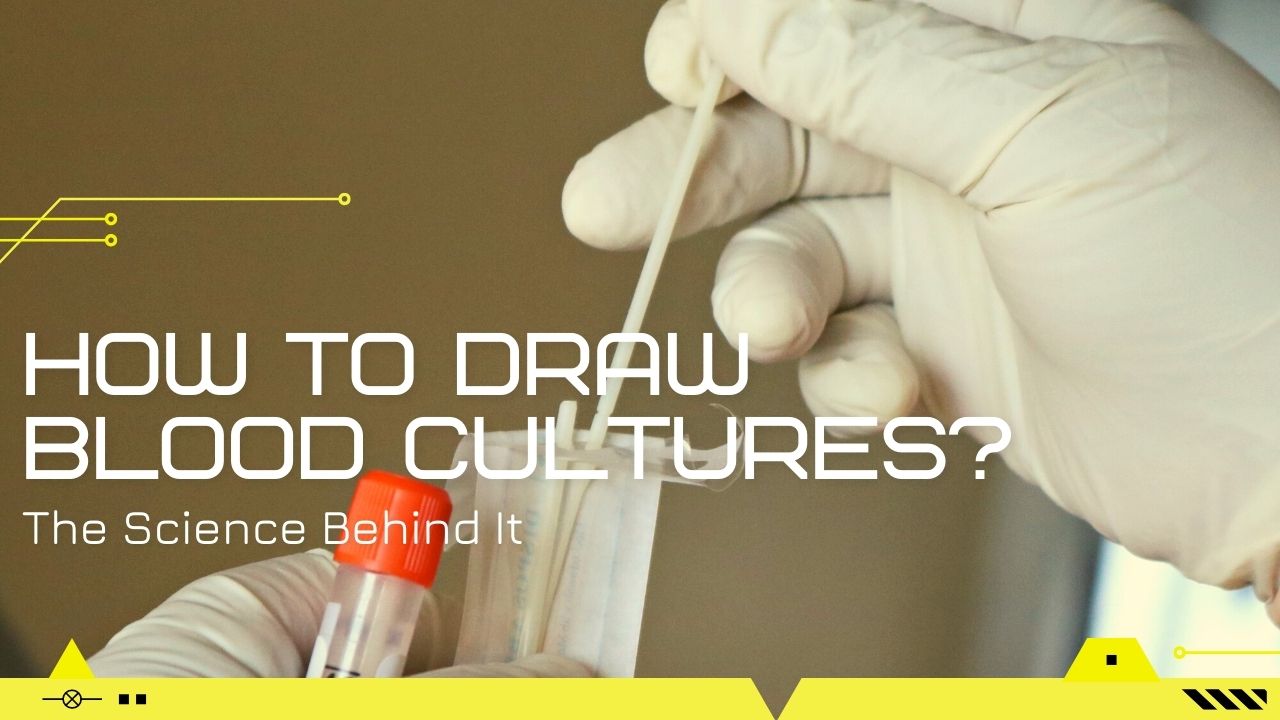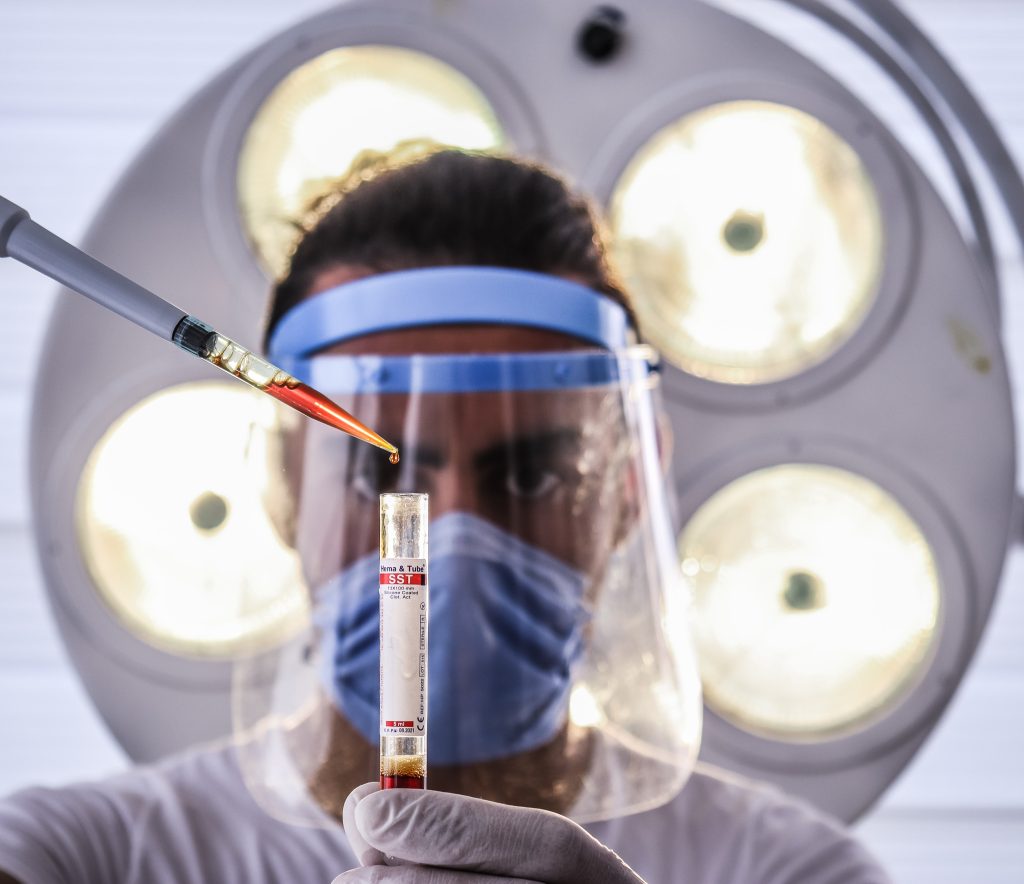How to draw blood cultures? The Science Behind It

One of the most common questions people related to the field of medicine ask is how to draw blood cultures? Beginners think it is very hard and complex to draw blood cultures whereas it is not as difficult as it seems to be. The trick is simple and all you need is just the right technique. That’s all. You just have to take care of a few things and rest you will be able to draw cultures with perfection.
You may have seen this most of the time that lab technicians usually draw two sets of blood cultures and that is to identify whether the cultures were contaminated in some way. In this article, we will discuss the right way to draw blood cultures without making any mistakes and without putting someone’s life in danger. So let’s get started.
Common Problems While Drawing Blood Cultures
Medicine is a tough field. Often beginners ask questions like how to draw blood cultures, how to avoid making mistakes, what is the best way to draw cultures etc. And most of the time, they have to answer people’s tough and silly questions as well. Some people are very curious to find out the answer to different sort of questions that at times does not make any sense. For example, they may ask you if crying helps make your eyelashes longer. Now as a student of medicine, you have to come up with the simplest explanation to clear your patient’s queries. You might go through a tough time but you will be able to answer such questions clearly after gaining experience
Although drawing blood cultures is not that hard, it is pretty simple. But that certainly does not mean you cannot face any issue. There are a few things that can go wrong during the process and that might put your patient’s life in danger. There are of course a few technicalities associated while drawing blood cultures. Let’s find out what are those and how you can avoid making mistakes and carry out the process smoothly.
Blood culture contamination is unfortunately pretty common and it’s due to non-sterile technique or essentially people not doing it correctly. Although it has long been recognized by people studying microbiology and physicians that blood cultures are one of the most essential laboratory procedures used in the identification of serious diseases, it has only recently become obvious that contaminated blood cultures are a widespread occurrence. Like some people take no care of the hygiene and they do not clean the equipment properly. So when you need to draw two sets of blood cultures, you need to select two different peripheral sites, for instance, you can use the right arm for one side, and then you can go to the left arm for the other side. If you are using a central line, then you are supposed to draw one set, then wait for like 15 mins. It is because, within 15 mins, the whole blood in the patient’s body is supposed to circulate again, and then it will be the time to draw the other site.
Moreover, one another issue with blood cultures is that sometimes you may get false positive reports. It should be noted that false-positive blood cultures result in additional laboratory testing, needless antibiotic administration, and patient hospitalization, all of which raise the cost of care for the patient.

Before drawing blood culture, the patient’s consent is very important.
What is the Main Purpose of Drawing Blood Cultures?
Before we get to the main question, how to draw blood cultures, we must understand what is the main purpose of drawing blood cultures. A blood culture is nothing but a minor test that examines your blood for foreign invaders such as bacteria, yeast, and other microbes. The presence of these bacteria in your bloodstream can indicate a blood infection, known as bacteremia. A positive blood culture indicates that germs are present in your blood.
This illness affects the blood that circulates throughout your body. Blood infections are commonly caused by bacteria that begin on your skin or in your lungs, urine, or gastrointestinal system. If an infection is severe or your immune system isn’t able to keep it isolated, it can move to your blood and become systemic. Sepsis is the medical term for a systemic infection. A simple blood sample is required for a blood culture test. The blood sample is tested at a laboratory and the results are sent to your doctor, who will use the information to determine how to treat any illness.
When your doctor suspects you have a blood infection, he or she will order blood cultures. Blood infections must be tested for since they might cause major problems. Sepsis is one such complication of a blood infection.
The bacteria that cause the infection in your circulation interfere with your body’s regular defenses and hinder your immune system from functioning correctly, resulting in sepsis. Toxins are also produced by pathogens, which can harm your organs. The test results can help your doctor figure out which organism or bacteria is causing the blood infection and how to treat it.
Common Symptoms of Blood Infection
Below is the list of common symptoms that shows you have a blood infection. If you encounter any of these signs and symptoms, don’t wait and head to the medical emergency straightaway. These symptoms include:
- Breathing too fast
- Fatigue
- Severe drowsiness
- High fever
- Body aches
- Muscle aches
- Headache
- Rapid heartbeat
- Shivers
- Chills
A blood infection can proceed to its most serious state, which is called sepsis if it is not treated. Sepsis symptoms include the ones listed above, as well as evidence of organ damage. Additional sepsis symptoms include the ones listed below.
- Frequent Urination
- Confusion
- Nausea
- Vomiting
Severe sepsis problems may develop as the infection advances. These can include symptoms like:
- Single or multiple organ failure
- Small blood clots throughout the body
- Body inflammation
- Low blood pressure
Furthermore, apart from Sepsis, Endocarditis, for example, can also be detected using a blood culture. Endocarditis is a disorder in which bacteria in your circulation adhere to your heart valves and causes inflammation. It has the potential to be fatal.
Besides, there are a few things that you should keep in mind while drawing blood cultures. For example, you may experience bleeding at the site of injection or hematoma which is referred to as bleeding underneath the skin. Now that you know what is blood culture and what potential risks you might encounter, it is time that we know how to draw blood cultures. Let’s get into it.
How To Draw Blood Cultures? The Correct Way
A microbiological culture of a peripheral blood sample is known as a blood culture. Culturing can reveal the presence of a systemic infection, such as septicemia because blood is generally a sterile environment. If a positive culture is obtained, the culprit microbe may typically be identified and antibiotic sensitivity testing is undertaken. Firstly you need to know what equipment will you be needing to draw blood cultures. Blood can be drawn in a hospital, an emergency room, or a specialized testing center. In an outpatient setting, blood cultures are not performed often.
Following is the list of tools and equipment that you will need to draw blood cultures.
- A biohazard bag
- Tourniquet
- Chlorohexidine Swabs or Alcohol Swabs whichever is indicated by your facility
- Blood culture bottles. One aerobic and one anaerobic
- Adapter
- Needle
- Sharpie or a marker
- Clean gloves
- Surgical gauze
- Sticking tape
To begin, the patient’s skin is cleansed to ensure that the test is not contaminated by any bacteria on your skin. A cuff or an elastic band is normally wrapped around your arm by your nurse or technician to allow your veins to fill with blood and become more apparent. They then take many blood samples from your arm with a single needle. If at all possible, the first collection should be via peripheral venipuncture (rather than through a line). If line sepsis is suspected or peripheral access sites are unavailable, the second site may be a central line. Sites on the outskirts are desirable. The choice to acquire a sample from a second site for pediatric patients is made at the discretion of the physician or nurse practitioner.
Moreover, Blood cultures are taken from central venous catheters or arterial lines when they are inserted in particular critical care units. Do not obtain blood cultures from an existing central or arterial line if line sepsis is suspected. Blood culture can be obtained in the dialysis bloodlines during a dialysis session in hemodialysis units.
It is worth noting that while drawing blood cultures, several blood samples are usually taken from various veins to improve the chances of identifying germs or fungi in your bloodstream. If you are an adult, your doctor or healthcare team will often draw two to three sometimes four blood samples from you throughout several appointments. Blood cultures can be collected in a short period of time, and empiric therapy can then be started. Blood cultures do not need to be taken at predetermined intervals. Multiple cultures should not be collected from a single venipuncture.
Once the blood culture is collected, the nurse or technician will apply gauze and a bandage to the puncture site. After getting done with that, the blood sample is then sent to a laboratory to be cultured. Each blood sample is placed in a vial containing broth, a liquid. The broth promotes the growth of any bacteria found in the blood sample.
Analyzing the Test Report
Finally, you got your answer to how to draw blood cultures, there are a few other things you should consider. Bear in mind that if in case your blood culture comes out positive, it suggests you have a bacterial or yeast infection. The results will typically assist your doctor in determining which bacteria or fungi are causing the ailment.
Your doctor will run a sensitivity or susceptibility test depending on the type of organism identified in your blood. This aids in determining which treatment will be most effective against that organism. Following up on a positive blood culture test with a sensitivity test is a routine procedure. When an infection is not responding to treatment, it can also be done.
Note that if in case your doctor or practitioner finds out that you have a blood infection, therapy with intravenous broad-spectrum antibiotics may begin straight away. While you wait for the blood culture or susceptibility testing results, this drug can begin battling a wide spectrum of bacteria. Blood infections must be treated right away, generally in a medical center or in a hospital. Sepsis can be fatal if it develops, especially if you have a weaker immune system. If you have sepsis, you will be admitted to the hospital for treatment.
Now that you know how to draw blood cultures, you should also be aware that if you’re in danger of getting a blood infection or if you’re experiencing any symptoms, you should immediately rush to the hospital and see a doctor or a physician. A doctor or other healthcare provider should always be consulted if a fever lasts more than three days. If your child is under the age of three months and has a fever, you should consult a doctor right once.
The Bottom Line
Bacteria and fungi are not commonly found in the blood. A blood culture is a test that looks for microorganisms (like fungus or bacteria) that can cause an infection in a blood sample. A sample of blood is placed in a material that encourages the growth of germs for a blood culture. A microscope or chemical tests can be used to determine the type of germ. Other tests may be performed in order to determine the best treatment for the infection. Sensitivity testing is the term for this.
Drawing blood cultures is not difficult at all. All you need is to know the right technique and gather the essential supplies. Besides, it is also important that you have knowledge regarding the potential risks that you might have during or after drawing a blood culture. Making sure you have the patient’s consent is as important as drawing the blood culture correctly. After explaining the entire procedure to the patient and having their consent, you can then carry out the process.

-
Culture3 years ago
Viking Braids: Styles, Ideas and Method for Men and Women
-
Culture3 years ago
Cultural Integration: Definition, Examples, And Benefits
-
Culture3 years ago
Carmen Winstead: Full Story About the Terrorized 17 Year Old Girl
-
Fitness3 years ago
Best Royal Rumble Matches In WWE History
-
Culture3 years ago
Germany or Sweden: Which is Better For Lifestyle And Why
-
Culture3 years ago
German Mythological Creatures from German Folklore
-
Culture3 years ago
Health Triangle: Everything You Need To Know About it
-
Culture3 years ago
10 Best Examples Of Folk Culture



















